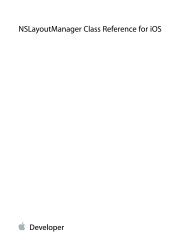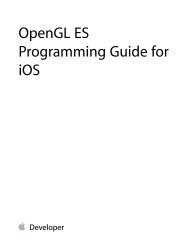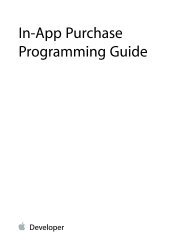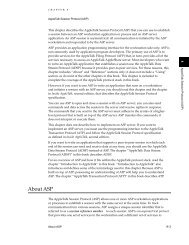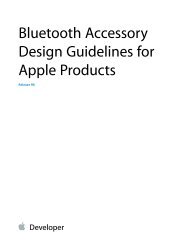URL Loading System Programming Guide - Apple Developer
URL Loading System Programming Guide - Apple Developer
URL Loading System Programming Guide - Apple Developer
Create successful ePaper yourself
Turn your PDF publications into a flip-book with our unique Google optimized e-Paper software.
Using NS<strong>URL</strong>Session<br />
Understanding <strong>URL</strong> Session Concepts<br />
The way your app behaves when it is relaunched differs slightly between iOS and OS X.<br />
In iOS, when a background transfer completes or requires credentials, if your app is no longer running, iOS<br />
automatically relaunches your app in the background and calls the<br />
application:handleEventsForBackground<strong>URL</strong>Session:completionHandler: method on your app’s<br />
UIApplicationDelegate object. This call provides the identifier of the session that caused your app to be<br />
launched. Your app should store that completion handler, create a background configuration object with the<br />
same identifier, and create a session with that configuration object. The new session is automatically reassociated<br />
with ongoing background activity. Later, when the session finishes the last background download task, it sends<br />
the session delegate a <strong>URL</strong>SessionDidFinishEventsForBackground<strong>URL</strong>Session: message. Your session<br />
delegate should then call the stored completion handler.<br />
In both iOS and OS X, when the user relaunches your app, your app should immediately create background<br />
configuration objects with the same identifiers as any sessions that had outstanding tasks when your app was<br />
last running, then create a session for each of those configuration objects. These new sessions are similarly<br />
automatically reassociated with ongoing background activity.<br />
Note: You must create exactly one session per identifier (specified when you create the configuration<br />
object). The behavior of multiple sessions sharing the same identifier is undefined.<br />
If any task completed while your app was suspended, the delegate’s<br />
<strong>URL</strong>Session:downloadTask:didFinishDownloadingTo<strong>URL</strong>: method is then called with the task and<br />
the <strong>URL</strong> for the newly downloaded file associated with it.<br />
Similarly, if any task requires credentials, the NS<strong>URL</strong>Session object calls the delegate’s<br />
<strong>URL</strong>Session:task:didReceiveChallenge:completionHandler: method or<br />
<strong>URL</strong>Session:didReceiveChallenge:completionHandler: method as appropriate.<br />
For an example of how to use NS<strong>URL</strong>Session for background transfers, see Simple Background Transfer .<br />
Life Cycle and Delegate Interaction<br />
Depending on what you are doing with the NS<strong>URL</strong>Session class, it may be helpful to fully understand the<br />
session life cycle, including how a session interacts with its delegate, the order in which delegate calls are<br />
made, what happens when the server returns a redirect, what happens when your app resumes a failed<br />
download, and so on.<br />
For a complete description of the life cycle of a <strong>URL</strong> session, read “Life Cycle of a <strong>URL</strong> Session” (page 64).<br />
2013-10-22 | Copyright © 2003, 2013 <strong>Apple</strong> Inc. All Rights Reserved.<br />
17




